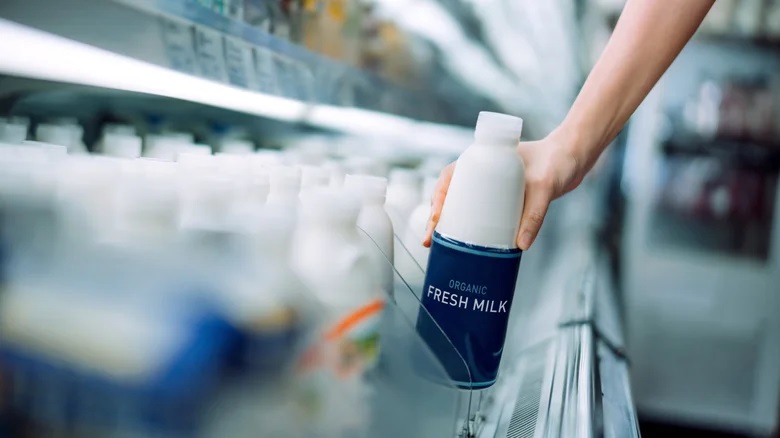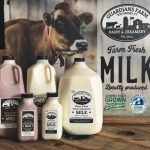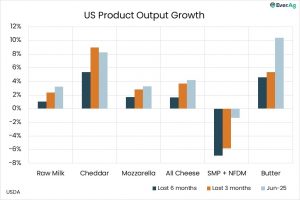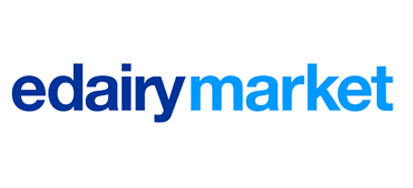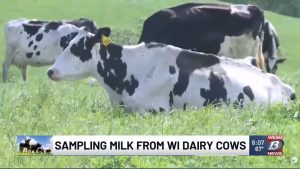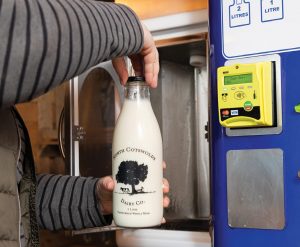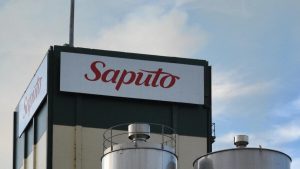
Milk has long been associated with good health, providing nutrients and protein while reducing obesity and boosting bone health.
But sometimes, things go sour. Throughout history, there have been countless recalls of the wholesome drink, mostly due to centralized production and tight food regulations, often affecting loads of people to varying degrees.
Food recalls usually happen when food is tainted or mislabeled. Once the Food Safety and Inspection Service (FSIS) is aware that a food product is unsafe, it promptly notifies the public to toss it. Of course, not everyone will be affected by a recall in the same way. Stores need to remove products from their shelves, employees in factories might get laid off, consumers have to double-check their purchases, and, more often than not, some people experience the wrath of the recall first-hand in the form of a foodborne illness. Milk and its associated products have been the source of plenty of recalls over the years. These are some of the biggest milk recalls that affected millions of people.
Raw Farm’s 2024 Bird Flu Outbreak

In 2024, a dangerous TikTok trend promoted drinking raw milk while failing to mention the hazards behind it. Some unlucky drinkers learned the hard way that it’s better to be safe than sorry with your choice of beverages after Raw Farm’s bird flu outbreak in 2024. Traces of the H5N1 virus were detected by the California Department of Food and Agriculture (CFDA) in November of that year, but not before wreaking havoc on the California-based milk company.
As the largest raw milk dairy company in the U.S., producing 70,000 gallons of milk per week, Raw Farm didn’t stand much of a chance against the virus that had affected over 500 herds across the Golden State last year. The company promptly placed all operations under quarantine and recalled the two lots of products that tested positive for bird flu.
The controversy over raw (or unpasteurized) milk stems from the fact that it bypasses the bacteria-killing heating process that the pasteurized milk goes through. With the risks of raw milk running high due to its disease-carrying nature, it’s not shocking that Raw Farm has been the source of a running list of recalls in its history. From E. coli and Campylobacter to salmonella and listeria, its record of contaminants spans nearly every year, with the bird flu being the latest but likely not the last.
Horizon Organic Dairy’s 2024 Milk Spoilage

Horizon Organic Dairy finished 2024 with less of a bang and more of a bust after 8-ounce cartons of its whole milk (12-packs as well as individual units) were taken off the market due to premature spoilage. The December 2024 recall, which affected products delivered to California, Nevada, and Arizona, involved nearly 20,000 cases. Despite the batch’s best-by date of March 3-7, heat damage as the milk was being packaged created the potential for spoilage for the cartons, which can be stored at room temperature and are refrigerated only after they are opened.
Recalls are divided into three classes, and this recall case was elevated in January 2025 to the second category, as the contamination meant that people were at a high risk of illness but without risk of death. You can stay prepared for the next inevitable contamination crisis by educating yourself on how to throw out recalled foods safely. If you end up consuming food that’s been recalled, don’t panic, but do seek medical attention immediately at the first sign of symptoms.
The 2024 Lactaid Milk Recall

Apparently 2024 was not a good year for milk drinkers. Though various recalls took place, the most expansive was likely that of Lactaid milk, which had been distributed to 27 states. During a routine maintenance program, five varieties of the brand’s milk showed traces of almond contamination, according to the Food and Drug Administration (FDA). In September 2024, the company immediately issued a recall, as the common allergen was not listed among the ingredients and could pose deadly health threats to unsuspecting consumers.
People who suffer from nut allergies can experience adverse reactions, including difficulty breathing, hives, swelling of the throat, or a drop in blood pressure, which can lead to anaphylaxis, sometimes even ending in death, at just the slightest consumption. That’s why the recall was listed as the most urgent of all, a Class 1. Luckily, Lactaid milk’s parent company, HP Hood LLC, acted swiftly with its voluntary product contamination alert that it said was done “out of an abundance of caution,” according to a statement released to Good Morning America. The public warning worked because no health issues were reported — quite the feat considering how many millions of people were at risk.
Canada’s 2024 Silk And Great Value Plant-Based Milk Recall

In this day and age, we’re bombarded with milk variations. Along with whole, 2%, low-fat, and fat-free milk from cows, there’s also almond, oat, soy, and cashew milks and more, making it difficult not only to pick the best plant-based milk to bake with but also the plant-based milk with the most protein. Though dairy milk is more commonly associated with contamination, the milk alternatives are not immune to recalls, as proven by last year’s widespread listeria crisis in Canada.
In the summer of 2024, reports of listeriosis began breaking out in eastern Canada after people had consumed non-dairy milks from both Silk and Great Value. The recall involved 18 separate products, including almond, oat, cashew, and coconut milks from the two brands. The specific source of the Listeria monocytogenes contamination was unknown, but it was linked to three deaths, 15 hospitalizations, and 20 reported illnesses spanning from Nova Scotia to Alberta. Like with all recalls, the number of people affected is likely much higher, but since people don’t always get tested after becoming ill, it’s tough to gauge precisely. In October of that year, the Canadian Food Inspection Agency released a statement expressing its condolences to the families who lost loved ones and ensured operations at a third-party manufacturing plant had ceased until conditions were up to code.
Snow Brand’s Mass Milk Poisoning In Japan In 2000

Milk was never a main staple in the Japanese diet until Americans brought dairy during their post-World War II occupation. But once it gained popularity in the island nation, there was no going back. Despite Japan consuming a one-third less milk compared to Western countries, plenty of people still quench their thirst with the white beverage. But a quarter century ago, about 14,780 consumers regretted their decision to down the calcium-rich drink after falling ill due to food poisoning.
The chaos was traced to the then-leading dairy manufacturer, Snow Brand. It all started with a power outage at its Taiki plant in Hokkaido that halted the production of its raw material, resulting in spoiled food that should have been discarded but was instead sent to the Kansai region at the opposite end of the country to continue in the production line. There, it created a toxic skim milk powder that ultimately sickened thousands of people in the city of Osaka in 2000 and may have contributed to the death of an 84-year-old woman. As if the situation wasn’t catastrophic enough, Snow Brand delayed advising both the public and its employees of the bad batch of products, which turned what could have been a reasonable recall into a historic disaster.
The incident marked Japan’s biggest food poisoning outbreak in 30 years. Just two years later, the company struck out again with another scandal when the managing director at the time, Hideki Takenouchi, admitted to the company’s tampering with the expiration dates of 760 metric tons of frozen butter as well as a scam involving repackaged meat. Irritated customers had had enough, and the business was liquidated in April 2002.
China’s Tainted Milk Scandal Of 2008

In 2008, a public health scandal resulted in at least 300,000 illnesses and six deaths, along with more than a dozen arrests and the execution of a dairy farmer and milk salesman identified as being the most responsible for the devastating crisis. When examining the details closely, it’s shocking to see how extensive the contamination was.
According to news accounts, the company Sanlu was aware in May 2008 that its baby formula was making children sick but didn’t tell public health officials until August, leaving a massive span of time for thousands more babies to fall ill. The reason? Melamine, a chemical used in plastic and fertilizer, had been added to raw milk to boost protein levels and pass nutritional tests. A lot of that tainted product ended up at Sanlu, which turned it into baby formula. But rather than nourish its young consumers, it caused mass cases of kidney stones and renal failure.
Investigators later traced the contamination to 22 other manufacturers of infant formula, according to a 2009 journal article in Environmental Health Perspectives. Melamine was also found in many other Chinese products, from milk to yogurt to cereal to frozen desserts. Even animal feed had been tainted, resulting in melamine showing up in meat, eggs, and more milk. In all, 47 countries received melamine-contaminated products from imports directly from China or through other countries.
The 2022 Lyons Magnus Recall

You might not be familiar with the name Lyons Magnus, but chances are you’ve heard of its oat milk brand, Oatly. The milk substitute is typically associated with good health, but in 2022, disaster struck the stomachs of consumers when microbial contamination spoiled Lyons Magnus’ beverage lines that included Oatly, Stumptown, and Intelligentsia. Initially, 53 versions of the plant-based beverages were recalled, with the number jumping to 90 products about a month later, all in time for minimal damage to take place from what’s believed to be a lack of sterile conditions during production.
One of the rare organisms polluting the drinks was Cronobacter sakazakii, which triggers symptoms including fever, vomiting, and urinary tract infections. Clostridium botulinum, which causes muscle weakness and paralysis, was also detected. Upon hearing the news, thousands of inconvenienced consumers were forced to double-check lot codes, labels, and expiration dates. No reported illnesses were on record; however, with that many products contaminated, people likely got sick without alerting authorities.
The 2002 Berkeley Farms Penicillin Contamination

Recalls usually involve foodborne pathogens like Salmonella and Listeria. However, in 2002, an unprecedented case of milk contamination revealed penicillin in various Berkeley Farms products. It’s actually normal for certain levels of the antibiotic to exist in milk, but in this case, a routine test detected life-threatening amounts of the allergen among products that included chocolate, strawberry, and standard milk.
The company, which hails from the Bay Area town of Hayward, had distributed the contaminated product among 10 different milk brands before realizing the danger. All but one of those brands were sold solely in Northern California. Even with a small geographical concentration, the scale of the crisis was considered significant. At least 3,000 grocery stores were notified to clear the problematic products off their shelves during this voluntary recall. Meanwhile, the gallons of drinkable dairy consumed before the recall are unknown.
Even though there were no reports of people getting sick, Berkeley Farms didn’t come out unscathed, as the business faced public scorn. Nearly two decades later, news outlets reported that the dairy producer filed for Chapter 11 bankruptcy in 2019 and was permanently closing in April 2020.
The 2024 Paradise Grove Dairy Campylobacter Outbreak

When you drink milk, you expect to get a dose of nutrients like calcium, protein, and vitamin D, but in the summer of 2024, people swallowed more than they bargained for when a bacteria infected the milk supply of the family-owned Idaho farm, Paradise Grove Dairy. The recall involved raw milk, which, with its recent internet craze, has had a negative chokehold on many. At least 18 people got sick with a microbial contaminant after drinking the dairy’s raw milk.
What many social media users don’t understand is that drinking raw milk puts you at risk of tuberculosis and other serious illnesses. The “over-processing” that TikTok gurus preach against with pasteurization is really just the way to kill harmful pathogens. The only natural benefits you’ll get from not pasteurizing your milk is in the form of all-natural bacteria. This time, it was the bacteria Campylobacter that caused chaos in the form of cramps, diarrhea, fever, and nausea.
Paradise Grove Dairy promotes its raw milk on its website, claiming that the A2/A2 protein in its product doesn’t cause inflammation that leads to intestinal issues. You know what does lead to intestinal issues? Campylobacter, Salmonella, E. coli, and other food poisoning pathogens often found in unpasteurized milk.
The Missoula, Montana, Salmonella Outbreak Of The ’80s

Do you know how you wash your hands when cooking an omelet because eggs can get salmonella? It turns out milk is susceptible to the deadly disease, too. Montana residents found this out the hard way when an outbreak was recorded in the 1980s that resulted in illnesses to over 100 people in Missoula. The outbreak also spurred legislative changes that unofficially affected many more.
Modern federal regulations, along with advances in technology, seem to have prompted more food recalls in recent years. In reality, though, people have been getting sick from germy milk since the agricultural revolution. It just so happens that this recorded outbreak spurred change.
The Missoula incident involved raw milk, which is known for containing hazardous bacteria. Its damaging and wide-ranging effects were the reason behind legislation that banned the commercial sale of unpasteurized milk in the state, though the law was reversed in 2021 to allow raw milk to be sold under certain criteria. In 2023, Missoula officials were out warning consumers about potential risks of drinking raw milk after reports of a potential bacterial exposure. In an interview with KPAX, city Environmental Health Director Shannon Therriault affirmed that “unpasteurized milk can contain harmful bacteria that can make you and your loved ones sick.”
The Lactalis Baby Formula Contamination In 2017

In 2017, millions of unsuspecting customers across 83 countries purchased what they later found out to be bad baby formula. A recall, which was spearheaded by the French company Lactalis, was shrouded in controversy. The business was accused of hiding a salmonella outbreak in its Craon factory in Mayenne, and its CEO, Emmanuel Besnier, took to the media to affirm that over 12 million boxes would be pulled from store shelves — but not before countless lawsuits were filed as a result of children getting sick.
The recall affected consumers in Europe, Asia, and Africa as well as parts of Central and South America. Besnier gave his word that he would compensate the families of the sickened infants, counting 38 reported cases in France along with additional incidents in Spain and Greece. At least 18 children required hospitalization.
This wasn’t the first or the last product recall by Lactalis, but it was by far the most sweeping. French authorities announced criminal charges in 2023 against the company for its role in the outbreak, but no resolution has been reported. Meanwhile, the company’s dairy business carries on. It’s set to acquire the General Mills U.S. yogurt market in 2025 for $2.1 billion.
You can now read the most important #news on #eDairyNews #Whatsapp channels!!!
🇺🇸 eDairy News INGLÊS: https://whatsapp.com/channel/0029VaKsjzGDTkJyIN6hcP1K
